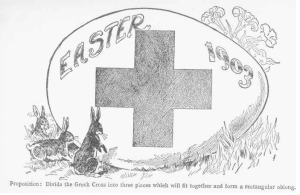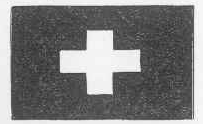A few weeks ago I posted some . Unfortunately I overlooked some of the puzzles created by Sam Loyd, so here is part 2. Sam Loyd must have been really fascinated by this shape, judging from the number of times he wrote about it.
1) Red Cross Volunteers

Here is a pretty little crutting puzzle, which is said to have originated in the mind of a red cross lassie while serving in Uncle Sam’s Ambulance Corps. It is safe to say that the bright witted little volunteer must have been a lineal descendent of Betsy Ross, who, it will be remembered designed the five-pointed star with one deft clip of her scissors. In the present instance it was necessary to practice strict economy in the manufacture of the red crosses to decorate the arms of the nurses, for the reason that the supply of red flanel was running very short in camp, so the problem presented is as follows: take a square pices of paper and without any waste cut it into five pieces which will fit together so as to make two Greek crosses of the same size.
This problem appeared on pages 199 of Sam Loyds cyclopedia of puzzles.
You can find the solution here
2) Divide the greek cross into three pieces

To illustrate the principle of working a puzzle backward, according to the axiom that a good rule should work both ways, we introduce a seasonable problem wherein the object is to discover how to divide a cross into three pieces which can be fitted together so as to form a rectangle which is twice as long as it is wide.
This, of course, is merely reversing the proposition of converting a rectangle into a greek cross, but, in that it presents the angles which must be fitted together, it is not so difficult as the other proposition.
This problem appeared on page 46 of Sam Loyds Cyclopedia of puzzles.
You can find the solution here
3) A swiss puzzle

Here is a very pretty trick performed by Miss Carré Schwitzer, which rivals Betsy Ross’ feat of producing a five pointed star with one clip of the scissors. When admiral Schwitzer asked his daughter to suggest an ensign for the Swiss navy, Carré seized an odd shaped remnant of red wall paper and skillfully divided it in two pieces which would fit together so as to form the Swiss flag with the white cross, as shown in her left hand.
When she was told of Betsy Ross’ feat she said she could go her one better. She took a Swiss flag, as here shown, and cut it into two pieces which would fit together and form a perfect square.

Of course if you can make a Swiss flag from a square, it is just as easy to reverse the operation – cut a square in two pieces which will form a flag.
4) The storm signal
Carré performed other feats with the Swiss flag which we will take occasion to mention. When she had charge of the signal station on Mt. Pilatus and whished to signal the fleet that a storm was rolling down the mountain, she took a square piece of bunting and cut it into two pices which would fit together and form the following flag.

In the Swiss language this tells of an approaching storm. Literally translated it says: “There will be a hot time in the old town tonight.”
Just to see how clever Miss Schwitzer was, try to cut the signal flag in two pieces which will form a perfect square.
5) Miss Schwitzer cont’d
Miss Schwitzer always acted on the square and was much respected on that account. She taught her Sunday School class how to cut three little squares into the fewest possible number of pieces so as to form one big square, and also the way to cut the three squares so as to form a Swiss cross. Try both of these puzzles.

6) Wilhelm Tell
William Tell asked her how to make a Maltese cross and she replied “Pull its tail”. She founded the order of the red cross.

There are two very beautiful puzzles connected with this cross, which are worth knowing: Cut the cross in two pieces which will form a rectangle, or cut it in three pieces which will make a perfect square.
We shall take early occasion to mention some of the marvelous feats performed by Carré Schwitzer in cutting Swiss cheeses, and juggling with pans of milk at her Swiss milk factory, near the chalk hills of Luzerne.
Problems 3-6 can be found on page 14 of Loyds cyclopedia of puzzles.
You can find the solutions for:
nr 3,
nr 4
nr 5
nr 6
7) The greek cross
There are also a number of puzzles on page 58, but I think they are largely overlappping with the puzzles above.
 At atheneum (high school), my mathematics teacher was drs. Hofman. One day in class he posed us the following problem:
At atheneum (high school), my mathematics teacher was drs. Hofman. One day in class he posed us the following problem:











